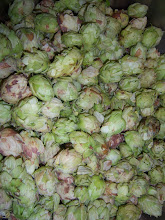 from the bottle a hazy toffee-colored brown with a light eggshell head. The nosy carries plenty of rich malt and smaller amounts of dark fruit—mostly of the raisin variety. There is also something slightly spritsy in the nose, but we can’t quite identify it. Auld Asheville has a big sweet malt front, moving into darker fruit flavors of raisin, currant, and cherry, and finishing with a bit of a spicy hop bitterness. The malt also reasserts itself in the final third, leaving the fruit flavors behind to set up the finish. The mouthfeel is chewy and rich; there is a medium to low carbonation level, and a medium to heavy body that is a little bit sticky. Auld Asheville is good, but not outstanding; it might benefit from a bit more aging to allow flavors to develop and marry together, and allow some of the stickiness to subside and mellow with age.
from the bottle a hazy toffee-colored brown with a light eggshell head. The nosy carries plenty of rich malt and smaller amounts of dark fruit—mostly of the raisin variety. There is also something slightly spritsy in the nose, but we can’t quite identify it. Auld Asheville has a big sweet malt front, moving into darker fruit flavors of raisin, currant, and cherry, and finishing with a bit of a spicy hop bitterness. The malt also reasserts itself in the final third, leaving the fruit flavors behind to set up the finish. The mouthfeel is chewy and rich; there is a medium to low carbonation level, and a medium to heavy body that is a little bit sticky. Auld Asheville is good, but not outstanding; it might benefit from a bit more aging to allow flavors to develop and marry together, and allow some of the stickiness to subside and mellow with age.From the bottle: “Highland’s 15th Anniversary Auld Asheville Ale has been brewed to celebrate our tradition of brewing fine quality ales and lagers. This version of an English Old Ale has a bold profile from fine British Malts, woodsy and estery aromas from traditional British ale yeast, and bittering from Styrian Bobek hops. The addition of Sterling hops provides a hint of spiciness in
 the nose. These flavors combined with a bright cheery redolence create a savory “Auld Ale” that will warm the dreariest of winter nights.”
the nose. These flavors combined with a bright cheery redolence create a savory “Auld Ale” that will warm the dreariest of winter nights.”From the Highland Brewing blog: “According to John Lyda, Highland’s Head Brewer, Auld Asheville Vintage Ale is a high gravity ale in the style of ‘Old Ales’ or ‘English Strong’ ales which are traditionally released just prior to the holidays. Contributing to the beer’s complexity is the use of three different yeast strains, two of which were imported from England. Because of the hopping levels, alcohol content, and the completeness of its attenuation with time in the tanks, ‘the product should cellar incredibly well and increase in complexity for at least the next year.’ Its taste is described as ‘having a bold profile from fine British Malts, woodsy and estery aromas from traditional British Ale yeast, and bittering from Styrian Bobek hops. The addition of Sterling hops provides a hint of spiciness in the nose.’”
ABV: 9.5%
(4/3/2010)

No comments:
Post a Comment